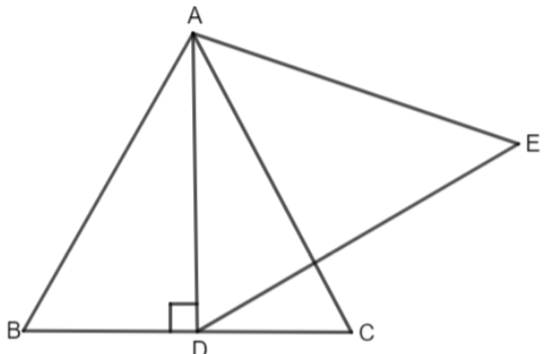
Answer
382.5k+ views
Hint: As we have both the triangles as equilateral triangles, so they are similar. We know that if triangle ABC is congruent to triangle PQR, then, \[\dfrac{Ar\left( \Delta ABC \right)}{Ar\left( \Delta PQR \right)}={{\left( \dfrac{AB}{PQ} \right)}^{2}}={{\left( \dfrac{BC}{QR} \right)}^{2}}={{\left( \dfrac{AC}{PR} \right)}^{2}}.\] So, we compare the sides to find the ratio of the area between triangle ADE and triangle ABC.
Complete step-by-step solution:
We are given that ABC is an equilateral triangle. Let us consider its side as ‘a’. So, we get,
\[AB=BC=AC=a......\left( i \right)\]
AD is the altitude through while we will construct another triangle ADE.

We know that in triangle ABC, altitude is the perpendicular bisector. So, we have,
\[BD=DC......\left( ii \right)\]
\[BC=BD+DC\]
From (ii), we have BD = DC, so we get,
\[\Rightarrow BC=BD+BD\]
\[\Rightarrow BC=2BD\]
So, we get,
\[\Rightarrow \dfrac{BC}{2}=BD\]
Noe from (i), we get,
\[BD=\dfrac{a}{2}....\left( iii \right)\]
As AD is a perpendicular bisector, we get triangle ABD as right triangle. Now, applying Pythagoras theorem in triangle ABD which says
\[A{{D}^{2}}+B{{D}^{2}}=A{{B}^{2}}\]
From here, we get,
\[A{{D}^{2}}=A{{B}^{2}}-B{{D}^{2}}\]
Using the value of (i) and (iii), we get,
\[A{{D}^{2}}={{a}^{2}}-\dfrac{{{a}^{2}}}{4}\]
\[\Rightarrow A{{D}^{2}}=\dfrac{4{{a}^{2}}-{{a}^{2}}}{4}\]
\[\Rightarrow A{{D}^{2}}=\dfrac{3{{a}^{2}}}{4}\]
Now, canceling square on both the sides, we get,
\[AD=\dfrac{\sqrt{3}a}{2}.....\left( iv \right)\]
So, we get the length of the sides of the triangle ADC as \[AD=\dfrac{\sqrt{3}a}{2}.\]
As triangle ABC and triangle ADE are both equilateral triangles, this means that both the triangles have all the angles as \[{{60}^{\circ }}.\] Therefore, by AAA similarity criteria, they are similar.
So,
\[\dfrac{Ar\left( \Delta ADE \right)}{Ar\left( \Delta ABC \right)}={{\left( \dfrac{AD}{AB} \right)}^{2}}\]
Using (i) and (iv), we get,
\[\Rightarrow \dfrac{Ar\left( \Delta ADE \right)}{Ar\left( \Delta ABC \right)}=\dfrac{{{\left( \dfrac{\sqrt{3}{a}}{2} \right)}^{2}}}{{{a}^{2}}}\]
\[\Rightarrow \dfrac{Ar\left( \Delta ADE \right)}{Ar\left( \Delta ABC \right)}=\dfrac{\dfrac{3{{a}^{2}}}{4}}{{{a}^{2}}}\]
\[\Rightarrow \dfrac{Ar\left( \Delta ADE \right)}{Ar\left( \Delta ABC \right)}=\dfrac{3{{a}^{2}}}{4{{a}^{2}}}\]
\[\Rightarrow \dfrac{Ar\left( \Delta ADE \right)}{Ar\left( \Delta ABC \right)}=\dfrac{3}{4}\]
So, we get,
\[\dfrac{Ar\left( \Delta ADE \right)}{Ar\left( \Delta ABC \right)}=\dfrac{3}{4}\]
Hence, option (a) is the right answer.
Note: The alternate method to find AD, i.e the altitude is as follows. We know that the area of the equilateral triangle is also given as
\[\text{Area}=\dfrac{\sqrt{3}}{4}\times {{\left( \text{side} \right)}^{2}}\]
In triangle ABC with base BC and altitude AD, we get,
\[\text{Area of }\Delta \text{ABC}=\dfrac{1}{2}\times BC\times AD\]
Also,
\[\text{Area of }\Delta ABC=\dfrac{\sqrt{3}}{4}{{\left( \text{side} \right)}^{2}}\]
\[\Rightarrow \text{Area of }\Delta ABC=\dfrac{\sqrt{3}}{4}\times B{{C}^{2}}\]
So comparing both, we get,
\[\dfrac{1}{2}\times BC\times AD=\dfrac{\sqrt{3}}{4}\times B{{C}^{2}}\]
Solving for AD, we get,
\[\Rightarrow AD=\dfrac{\sqrt{3}}{4}\times B{{C}^{2}}\times \dfrac{2}{BC}\]
\[\Rightarrow AD=\dfrac{\sqrt{3}}{2}\times BC\]
As BC = a, we can write as,
\[\Rightarrow AD=\dfrac{\sqrt{3}}{2}a\]
Complete step-by-step solution:
We are given that ABC is an equilateral triangle. Let us consider its side as ‘a’. So, we get,
\[AB=BC=AC=a......\left( i \right)\]
AD is the altitude through while we will construct another triangle ADE.

We know that in triangle ABC, altitude is the perpendicular bisector. So, we have,
\[BD=DC......\left( ii \right)\]
\[BC=BD+DC\]
From (ii), we have BD = DC, so we get,
\[\Rightarrow BC=BD+BD\]
\[\Rightarrow BC=2BD\]
So, we get,
\[\Rightarrow \dfrac{BC}{2}=BD\]
Noe from (i), we get,
\[BD=\dfrac{a}{2}....\left( iii \right)\]
As AD is a perpendicular bisector, we get triangle ABD as right triangle. Now, applying Pythagoras theorem in triangle ABD which says
\[A{{D}^{2}}+B{{D}^{2}}=A{{B}^{2}}\]
From here, we get,
\[A{{D}^{2}}=A{{B}^{2}}-B{{D}^{2}}\]
Using the value of (i) and (iii), we get,
\[A{{D}^{2}}={{a}^{2}}-\dfrac{{{a}^{2}}}{4}\]
\[\Rightarrow A{{D}^{2}}=\dfrac{4{{a}^{2}}-{{a}^{2}}}{4}\]
\[\Rightarrow A{{D}^{2}}=\dfrac{3{{a}^{2}}}{4}\]
Now, canceling square on both the sides, we get,
\[AD=\dfrac{\sqrt{3}a}{2}.....\left( iv \right)\]
So, we get the length of the sides of the triangle ADC as \[AD=\dfrac{\sqrt{3}a}{2}.\]
As triangle ABC and triangle ADE are both equilateral triangles, this means that both the triangles have all the angles as \[{{60}^{\circ }}.\] Therefore, by AAA similarity criteria, they are similar.
So,
\[\dfrac{Ar\left( \Delta ADE \right)}{Ar\left( \Delta ABC \right)}={{\left( \dfrac{AD}{AB} \right)}^{2}}\]
Using (i) and (iv), we get,
\[\Rightarrow \dfrac{Ar\left( \Delta ADE \right)}{Ar\left( \Delta ABC \right)}=\dfrac{{{\left( \dfrac{\sqrt{3}{a}}{2} \right)}^{2}}}{{{a}^{2}}}\]
\[\Rightarrow \dfrac{Ar\left( \Delta ADE \right)}{Ar\left( \Delta ABC \right)}=\dfrac{\dfrac{3{{a}^{2}}}{4}}{{{a}^{2}}}\]
\[\Rightarrow \dfrac{Ar\left( \Delta ADE \right)}{Ar\left( \Delta ABC \right)}=\dfrac{3{{a}^{2}}}{4{{a}^{2}}}\]
\[\Rightarrow \dfrac{Ar\left( \Delta ADE \right)}{Ar\left( \Delta ABC \right)}=\dfrac{3}{4}\]
So, we get,
\[\dfrac{Ar\left( \Delta ADE \right)}{Ar\left( \Delta ABC \right)}=\dfrac{3}{4}\]
Hence, option (a) is the right answer.
Note: The alternate method to find AD, i.e the altitude is as follows. We know that the area of the equilateral triangle is also given as
\[\text{Area}=\dfrac{\sqrt{3}}{4}\times {{\left( \text{side} \right)}^{2}}\]
In triangle ABC with base BC and altitude AD, we get,
\[\text{Area of }\Delta \text{ABC}=\dfrac{1}{2}\times BC\times AD\]
Also,
\[\text{Area of }\Delta ABC=\dfrac{\sqrt{3}}{4}{{\left( \text{side} \right)}^{2}}\]
\[\Rightarrow \text{Area of }\Delta ABC=\dfrac{\sqrt{3}}{4}\times B{{C}^{2}}\]
So comparing both, we get,
\[\dfrac{1}{2}\times BC\times AD=\dfrac{\sqrt{3}}{4}\times B{{C}^{2}}\]
Solving for AD, we get,
\[\Rightarrow AD=\dfrac{\sqrt{3}}{4}\times B{{C}^{2}}\times \dfrac{2}{BC}\]
\[\Rightarrow AD=\dfrac{\sqrt{3}}{2}\times BC\]
As BC = a, we can write as,
\[\Rightarrow AD=\dfrac{\sqrt{3}}{2}a\]
Recently Updated Pages
How many sigma and pi bonds are present in HCequiv class 11 chemistry CBSE

Mark and label the given geoinformation on the outline class 11 social science CBSE

When people say No pun intended what does that mea class 8 english CBSE

Name the states which share their boundary with Indias class 9 social science CBSE

Give an account of the Northern Plains of India class 9 social science CBSE

Change the following sentences into negative and interrogative class 10 english CBSE

Trending doubts
Fill the blanks with the suitable prepositions 1 The class 9 english CBSE

Which are the Top 10 Largest Countries of the World?

Give 10 examples for herbs , shrubs , climbers , creepers

Difference Between Plant Cell and Animal Cell

Difference between Prokaryotic cell and Eukaryotic class 11 biology CBSE

The Equation xxx + 2 is Satisfied when x is Equal to Class 10 Maths

Change the following sentences into negative and interrogative class 10 english CBSE

How do you graph the function fx 4x class 9 maths CBSE

Write a letter to the principal requesting him to grant class 10 english CBSE



